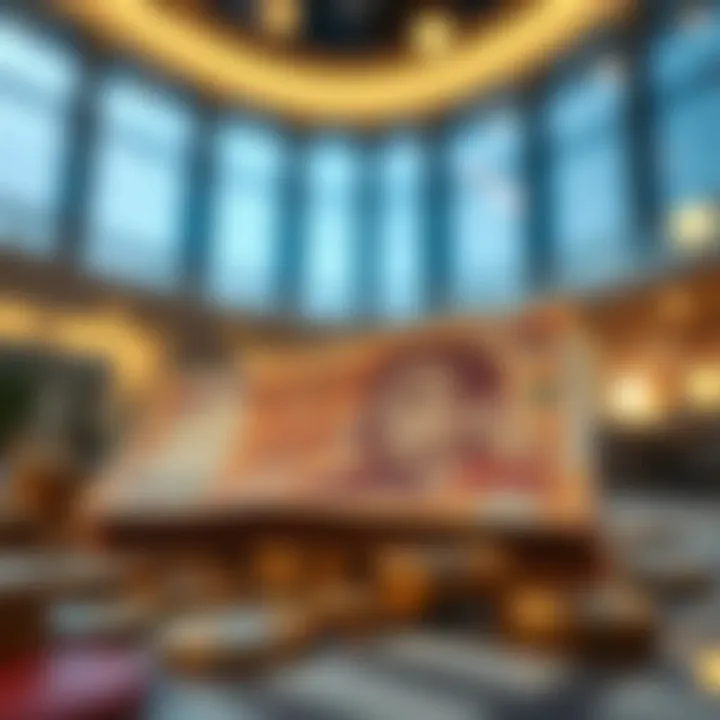Currency Conversion Insights: 2 Lakh AED to INR


Intro
Understanding the mechanisms behind currency conversion is crucial for anyone involved in global transactions or investments. With the rise of Dubai as a financial hub, the conversion of 2 lakh AED to INR holds significance not merely in numbers, but in the economic narratives that encompass investments, property purchase, and the broader implications of currency fluctuations.
Dubai's real estate market is a magnet for investors and expatriates alike, and currency rates can sway decisions significantly. For example, with the current exchange rate hovering around 1 AED equalling approximately 22 INR, the conversion of 2 lakh AED amounts to around 44 lakh INR. However, this numeric conversion is just the tip of the iceberg.
Market volatility can alter these numbers from day to day, affecting purchasing power and strategies for buyers looking at properties in Dubai. Understanding exchange rates, the factors that drive them, and their impact on investments is essential for investors and homebuyers who do not want to leave their fates in the hands of fluctuating markets.
This article will delve deeper into not only the current trends in Dubai's real estate market but will also provide insights into future opportunities fueled by currency conversion dynamics. It aims to equip the reader with knowledge that fosters informed decision-making, especially as we explore the intertwining realms of currency conversion and investment in Dubai's dynamic economic environment.
Prelude to Currency Conversion
Currency conversion is a fundamental aspect of international finance, impacting everything from tourism to foreign investments. This article focuses on converting 2 lakh AED into INR, providing essential insights for investors, homebuyers, and expatriates alike. Understanding how currency conversion works is pivotal for making informed financial decisions, particularly in markets like Dubai's real estate, where currency fluctuations can affect property prices significantly.
When dealing with different currencies, knowing the current exchange rates is just the tip of the iceberg. Factors influencing these rates can range from economic stability and interest rates to geopolitical events and natural disasters. A savvy investor must grasp these dynamics not only to secure the best exchange rates but also to hedge against potential losses that could arise from sudden shifts in value.
Key Elements of Currency Conversion
- Economic Indicators: Understanding macroeconomic indicators, such as inflation rates and GDP growth, can provide insights into currency behavior.
- Market Sentiment: Currency values often reflect investor sentiments and speculations, which can lead to rapid price fluctuations.
- Supply and Demand Influences: The volatility of a currency also hinges on its accessibility and the demand for the underlying economy's goods and services.
Benefits of Understanding Currency Conversion
Grasping the nuances of currency conversion offers several benefits:
- Informed Investment Decisions: Investors can tailor their strategies based on exchange rate predictions, maximizing returns.
- Cultural Exchange: For expatriates or frequent travelers, familiarizing oneself with currency conversion can enhance the experience, reducing the risk of overspending in unfamiliar markets.
- Prudent Financial Planning: Understanding when to exchange your currency may save money and impact budget considerations.
Considerations About Currency Conversion
Currency conversion isn’t just about numbers; it also encompasses considerations regarding the right time to exchange and where to conduct exchanges, whether through banks, currency exchange platforms, or online services. Each platform offers different rates, and sometimes, transaction fees can chip away at your hard-earned savings.
Ultimately, delving into the mechanics of currency conversion is valuable for anyone navigating today’s globalized economy. This article aims to streamline and demystify the process, particularly for those interested in real estate opportunities within Dubai, aligning both strategy with informed decision-making for fruitful investments.
Understanding AED and INR
In the context of currency conversion, understanding the United Arab Emirates Dirham (AED) and the Indian Rupee (INR) is fundamental. These two currencies not only represent their respective nations but also embody the economic climates and investment landscapes therein. For anyone involved in business, trading, or real estate investments in Dubai or India, a comprehensive grasp of these currencies is vital. This knowledge helps to make informed decisions that can save money and minimize risks, especially in fluctuating markets.
Overview of the United Arab Emirates Dirham
The United Arab Emirates Dirham is more than just a means of payment; it's a pillar of economic stability for the UAE. Established in 1973 to replace the Qatar and Dubai Riyal, the Dirham is pegged to the U.S. dollar, which means its value remains relatively stable compared to many other currencies. This peg provides a level of confidence for investors and businesses alike, ensuring more predictable economic conditions.
When evaluating the AED, consider its role in the broader Middle Eastern economy. It serves as a crucial point for trade, tourism, and expatriate workforces, primarily in cities like Dubai. Some key aspects include:
- Stability and Trust: The peg to the USD provides a steady framework, which encourages both local and foreign investments.
- Global Trade: With the growing significance of the UAE as a trade hub, understanding the AED is critical for businesses interacting with various international partners.
- Tourism Impact: With millions flocking to Dubai for tourism, evaluating currency exchange rates becomes significant for those looking to convert their home currency into AED.
Overall, understanding the Dirham's role will benefit any investor or expatriate looking to maximize their opportunities in the region.
Overview of the Indian Rupee
The Indian Rupee is a complex currency reflecting the vibrant and often tumultuous economy of India. The Reserve Bank of India oversees its regulation, and unlike the Dirham, the Rupee is not pegged to any major global currency. This means its value can fluctuate based on various domestic and global factors, including inflation rates, economic performance, and political stability.


The significance of INR extends beyond borders, particularly amidst the growing Indian diaspora and international investors looking at India as a market. Consider these aspects:
- Volatility: Investors ought to recognize the risks associated with converting currency in an environment where the INR's value can shift dramatically based on market sentiment.
- Economic Indicators: Various factors can impact the Rupee’s strength, such as India's balance of trade, foreign investment levels, and economic policies.
- Opportunities: For expatriates and investors, understanding the INR provides insights into potential growth areas within India’s diverse economy.
In short, grasping the nuances of the Indian Rupee will empower individuals and businesses to make savvy investment choices and currency movements, especially as they relate to luxury real estate and other sectors in India.
Current Exchange Rate Analysis
Understanding the current exchange rate is crucial for anyone dealing with currency conversion, whether for investment, travel, or business transactions. The analysis of the exchange rate between the United Arab Emirates Dirham and the Indian Rupee provides valuable insights that can influence strategic financial decisions.
When investors and buyers consider converting 2 lakh AED to INR, they must take into account various factors that affect the exchange rate, including economic performance, geopolitical stability, and market demand. By gaining a deeper understanding of these factors, individuals can make more informed decisions, potentially saving or earning substantial amounts depending on the market conditions.
Beyond just conversion rates, the current exchange rate impacts purchasing power and the overall value of investments, especially in volatile markets like real estate. As such, investors must stay updated with the latest exchange trends and economic updates to optimize their financial planning and mitigate risks associated with currency fluctuations.
Factors Influencing Exchange Rates
Exchange rates do not exist in a vacuum; they are influenced by a myriad of elements, each interacting to reflect the financial health of a country. Here are some of the key factors:
- Interest Rates: Higher interest rates offer lenders a better return relative to other countries, which tends to attract foreign capital and causes the exchange rate to increase.
- Inflation Rates: A lower inflation rate in a country as compared to others will increase that country's currency value. It reflects a stable economic environment, attracting foreign investment.
- Political Stability: Countries with less risk for political turmoil are more attractive to foreign investors, which can strengthen their currencies. For instance, economic policies in the UAE that promote real estate growth often correlate with a favorable exchange rate.
- Economic Indicators: Statistics such as gross domestic product, employment rates, and manufacturing output provide insights into the health of an economy, guiding investors in their predictive evaluations of currency strength.
By analyzing these factors, one can develop a clearer picture of what to expect from the AED to INR conversion process.
Historical Trends in AED/INR Conversion
Looking back, the historical trends in the exchange rate between the AED and INR can reveal patterns that might help anticipate future shifts. Over the years, the value of the Dirham has fluctuated significantly against the Rupee due to varying economic conditions, both domestically and internationally.
For example, periods of high inflation in India typically lead to a weaker Rupee. Conversely, stability in the UAE's economic policies has often kept the Dirham strong. Investors should be mindful of these historical shifts as they can indicate potential future movements.
- Long-Term Trends: Observing long-term graphs can provide insights into overall trends and performance. Since 2000, the Dirham has shown varying strength against the Rupee, often reflecting significant events in either nation's economy.
- Recent Developments: In recent years, the exchange rate has also been influenced by shifts in oil prices, economic sanctions, or geopolitical tensions in the Middle East, while also needing to keep an eye on India’s economic growth predictions.
Staying informed about historical trends allows investors to time their conversions more effectively, thus enhancing their investment strategies. For detailed data and statistics, you can consult Wikipedia or Britannica.
The exchange rate analysis, including the factors influencing it and the historical context, provides a solid groundwork for understanding the conversion process from 2 lakh AED to INR, shaping decisions that can have lasting implications.
The Conversion Process: Lakh AED to INR
When it comes to exchanging currencies, especially with significant amounts like 2 lakh AED, the conversion process is a crucial element that cannot be overlooked. Understanding how this process works is essential for investors, buyers, and anyone interacting with international markets. The conversion from AED to INR involves more than a simple exchange; it reflects current economic conditions, market dynamics, and even geopolitical factors.
This section explores the process in detail, highlighting the benefits and considerations that come with converting AED to INR. It’s vital for investors who wish to make informed decisions while navigating Dubai's booming real estate market. Knowing the conversion procedure helps one assess potential investment opportunities and financial risks effectively.
Step-by-Step Conversion Calculation
Calculating the conversion from 2 lakh AED to INR is fairly straightforward once you understand the exchange rate. Here’s a simple breakdown:
- Find the Current Exchange Rate: To begin with, check the current exchange rate for AED to INR from reliable financial news sources or financial institutions. For instance, if 1 AED is equivalent to 22 INR, then you have a benchmark to work from.
- Multiply by the Amount: Using the exchange rate, multiply the amount in AED by the exchange rate. In our case:This calculation gives you the total amount in INR.
- Consider Additional Fees: Remember that financial institutions often charge fees or commissions for currency conversion, which can impact the final amount you receive. It’s smart to inquire about these fees before proceeding with the conversion.
- Review the Result: After accounting for all aspects, you’ll have a clearer understanding of how much 2 lakh AED translates into INR after conversion.
This step-by-step method can be applied whether you’re converting through a bank, a currency exchange service, or an online platform, ensuring a comprehensive grasp of the financial transaction.
Using Online Currency Converters
In today’s digital age, online currency converters have become an accessible tool for many. These platforms simplify the conversion process, giving real-time results based on the most current exchange rates. However, while convenience is a major plus, it is also essential to choose reliable sources.


Here are a few points to consider:
- Reputable Converters: Websites like XE.com and OANDA.com are popular for real-time conversions and usually provide accurate rates.
- International Rates: Most online converters reflect mid-market rates, which might differ from the rates a bank or exchange may offer; thus, it’s wise to keep that in mind.
- User-Friendly Interface: Look for converters that allow you to input your specific amounts easily and showcase the rate trends over time, helping you make informed decisions.
- Mobile Apps: Many mobile applications also provide currency conversion on-the-go, offering added convenience and flexibility.
Using online converters adds efficiency to the conversion process, but always cross-check rates from multiple sources to ensure accuracy.
In summary, while converting 2 lakh AED to INR, understanding the calculation process and leveraging online tools can significantly streamline the experience. The approach not only enhances awareness of financial movements but also fortifies strategic investment decisions.
Implications for Real Estate Investments
When it comes to understanding the dynamics of currency conversion, particularly in the context of real estate investments, the implications are multifaceted. Currency fluctuations have a tangible impact on buying power, pricing strategy, and overall investment returns. As Dubai stands out as a major global hub, investors need to consider the interplay between currency exchange rates and real estate, especially regarding values tied to the United Arab Emirates Dirham (AED) and the Indian Rupee (INR).
Investing in property involves significant capital, and even small swings in currency exchange rates can drastically affect the bottom line for investors and homebuyers. The implications are profound, and understanding these can lead to more informed investment decisions. Importantly, investors must be aware of how the conversion of 2 lakh AED to INR can shape their opportunities and risks.
Investment Opportunities in Dubai
Dubai’s real estate market is often viewed as a goldmine for savvy investors. The emirate offers a variety of investment options, from luxury villas to commercial spaces. The thriving economy and a steady influx of tourists bolster real estate demand, which can drive prices upward. With the current exchange rate, converting AED to INR provides a unique opportunity, making property more accessible for Indian investors.
- Diverse Property Market: Dubai features varied real estate offerings, appealing to different investment appetites.
- Regulatory Ease: Foreign ownership laws favor investors, with designated areas allowing complete freehold ownership.
- Rental Yields: The rental returns in Dubai are generally robust, often ranging between 6-8%, providing a steady income stream for investors.
- Luxury apartments and villas in areas like Palm Jumeirah attract high-net-worth individuals.
- Emerging neighborhoods such as Dubai South provide affordable options but with substantial growth potential.
With the conversion rate favoring the AED, Indian investors looking at Dubai property can leverage their capital effectively.
Risk Factors in Currency Fluctuations
While opportunities abound, one must not overlook the inherent risks of currency fluctuations. Changes in exchange rates can translate into losses, affecting the overall investment landscape. Fluctuations can happen due to various external factors, such as economic indicators, geopolitical events, and changes in monetary policies.
- Market Volatility: Rapid shifts in exchange rates can lead to unexpected costs. For instance, if the INR weakens significantly against the AED, the cost of purchasing a property suddenly rises. This can potentially price out buyers or reduce the profitability of an investment.
- Hedging Strategies: Investors might consider hedging against currency risk through forward contracts or options to lock in favorable rates.
- Economic Indicators: Monitoring trends in the economies of both the UAE and India is vital. Economic growth in India may strengthen the INR, whereas a downturn could have the opposite effect.
Awareness of these risks can help investors formulate a more robust investment strategy.
Long-Term vs Short-Term Investments
The decision between a long-term investment or a short-term flip is paramount in the current climate. This choice is often influenced by currency conversion dynamics, particularly the exchange rate between AED and INR.
- Long-Term Investments: Holding properties over time allows investors to ride out currency fluctuations. Rent collected can also provide returns while property values appreciate. In Dubai, many investors favor this strategy due to consistent demand and economic growth.
- Short-Term Investments: Speculating on quick sales can yield significant profits if timed correctly, especially in a booming market like Dubai. However, this approach carries higher risks in a fluctuating currency environment.
Comparative Analysis of Currency Strength
The comparative analysis of currency strength is pivotal for understanding the broader economic landscape. It allows investors, homebuyers, and expatriates to assess the financial viability of their decisions, particularly when evaluating investments abroad, like in the robust Dubai real estate market. When we look deeper into how one currency stacks up against another, it helps us to not only gauge individual purchasing power but also offers insights into the overall health of an economy.
Understanding currency strength equips individuals to make informed decisions about when to exchange or hold onto their capital. For example, during times of economic uncertainty, the strength of a currency can fluctuate significantly based on myriad factors, including political stability, trade balances, and interest rates. Thus, a keen grasp on these dynamics proves beneficial in not just optimization of investments but also risk mitigation.
AED Compared to Other Currencies
When we look at the United Arab Emirates Dirham (AED), its strength against other currencies can paint a vivid picture of its stability and desirability in the global market. Particularly, the AED is pegged to the US Dollar, which provides it with a degree of steadfastness.
- Stability: This peg to the dollar means that the Dirham tends to exhibit less volatility than many other currencies, particularly those that fluctuate based on market sentiment. This stability makes the AED a safer choice for transactions and investments, appealing largely to foreign investors looking for reliable returns.
- Competitive Edge: Compared to regional neighbors, the AED often holds a strong position. For instance, when compared to the Saudi Riyal or Qatari Rial, the Dirham maintains robust purchasing power, further making it viable for expatriates wishing to settle in the UAE or considering investments in real estate.
This solid footing helps neutralize risk in investments, especially in significant expenditures like property purchase, thus allowing foreign buyers to feel more secure in their decisions.


INR Strength in the Global Market
Shifting the focus to the Indian Rupee (INR), its standing in the global market offers a different narrative. While not as stable as the AED due to macroeconomic factors, the INR holds importance for both Indian expatriates and foreign investors looking at the Indian economy.
- Market Dynamics: The strength of the INR is influenced by several intertwined elements including inflation rates, recent government policies, and global economic conditions. Investors targeting India must consider such variables intricately.
- Potential Growth: Although the INR may not always compare favorably with stronger currencies, it presents a tantalizing opportunity for investors interested in long-term growth. India's booming economy, combined with its large consumer market, creates enticing prospective returns on investments, particularly in real estate and technology sectors.
In summary, the notion of currency strength is far from superficial—it delves deep into the financial fabric of markets and economies. Observations and analyses regarding the AED and INR can serve as vital indicators for investors looking to navigate the tides of currency conversion, alongside its implications in the context of real estate investments in Dubai and India.
To truly maximize investment potential, both understanding the mechanics of currency strength and diligently monitoring it becomes indispensable for savvy investors and expatriates alike.
Practical Considerations for Investors
When venturing into the world of currency conversion, especially regarding a significant amount like 2 lakh AED to Indian Rupees, it’s essential for investors to be mindful of several practical aspects. Understanding the nuances of currency exchange can lead to more informed decisions, which is especially crucial in volatile markets like real estate in Dubai and India.
Investors often focus solely on the numbers, but there's more to it than meets the eye. Factors such as fees, timing, and security play a vital role in ensuring that the conversion process aligns with one's financial goals.
One of the primary considerations is safety during currency exchange. Whether it’s through a bank, an online service, or a money exchanger, knowledge about which method suits your needs is paramount. Not only do you want to avoid hidden fees, but ensuring a secure transaction is just as important to protect your investment.
Moreover, having a grasp on how to time your currency exchanges can influence the total amount received in INR. With sudden fluctuations in exchange rates, making timely decisions can save money. If your timing is off, what could have been a profitable transaction might instead turn into a regrettable one.
How to Safely Exchange Currency
The first step toward a secure currency exchange is to choose a reputable and trustworthy source. Banks and well-known financial institutions generally provide a safer option, though they might charge higher fees. Online platforms can offer competitive rates, but they require more diligence in investigating their legitimacy.
Here are some tips for a safe currency exchange:
- Verify Credentials: When using an online platform or physical exchange, ensure it is licensed and regulated in your jurisdiction.
- Read Reviews: Look for feedback from other users to gauge the reliability of the service.
- Use Strong Security Practices: Enabling two-factor authentication on online platforms is advisable. Keep your information private and avoid sharing personal details unless absolutely necessary.
Additionally, always compare exchange rates before proceeding. Small differences can lead to significant financial implications.
"Seemingly, a tiny fraction of a rate can morph a boss decision into just another day at the office."
Timing Your Currency Exchange
Timing is often the unsung hero of successful currency conversions. The right timing can maximize your yield when converting AED to INR. Currency values can shift like sands underfoot, so keeping an eye on the market can reveal the best moments to exchange.
A few strategies for timing your currency exchange include:
- Monitor Market Trends: Use financial news websites or apps to follow trends in currency exchange rates. Trading platforms sometimes provide real-time data that could assist in decision-making.
- Set Alerts: Some platforms allow users to set exchange rate alerts. This can save time and ensure that you engage in currency conversion when rates are favorable.
- Consult Financial Experts: If you're uncertain about market conditions, consulting a financial advisor can provide deeper insights regarding when to make your move.
For individuals looking to invest in Dubai's real estate market, understanding and utilizing these practical considerations can significantly impact investment success. Currency conversion isn't merely a numbers game; it's about making savvy, well-informed choices that resonate throughout your financial journey.
Closure
In this article, we've taken a comprehensive look at the conversion of 2 lakh AED into INR, understanding how currency conversion works and the implications it has for various stakeholders, particularly in the ever-evolving Dubai real estate market. The significance of grasping currency valuation is paramount, not just for investors looking for opportunities, but for individuals and families considering setting down roots in foreign lands.
Understanding currency conversion goes beyond numbers. It encompasses a realm of interconnected factors including economic conditions, market trends, and geopolitical influences. Proper knowledge can serve as a toolkit for making prudent investment decisions, allowing one to navigate the unpredictable seas of exchange rates with more assurance.
Investors, homebuyers, expatriates, and those involved in international trade should consider the following key elements:
- Market Volatility: The forex market is highly dynamic. Hence, a clear grasp of the timing and strategy behind currency exchanges can significantly improve the potential gains.
- Investment Decisions: The interconnectedness of currency strength and real estate pricing underscores the need for astute observations and timing. A falling INR, for instance, can make Diabni properties more appealing to foreigners, changing investment strategies.
- Economic Landscape: Being informed about broader economic factors, such as inflation rates or oil prices, also plays a critical role in understanding how they will influence currency values.
"In the world of currency conversion, knowledge is not just power; it is a pathway to financial safety and growth."
This exploration has laid foundational insights which can aid both novice and seasoned investors in navigating complex financial waters. The information shared herein serves to enlighten and equip readers with the necessary tools to engage with currency conversion meaningfully. By channeling this understanding, stakeholders can better position themselves to seize opportunities that come with the fluctuations and trends of currency markets, especially for those eyeing investments in Dubai's dynamic real estate sector.
For further reading on currency exchange dynamics and their implications, you may explore resources like Investopedia, Wikipedia, and The Economic Times.







